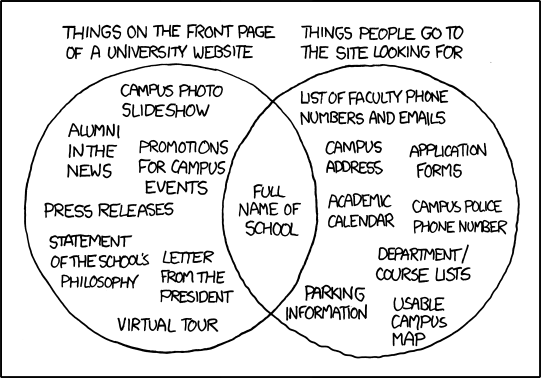
On Meet Content, we talk a lot about the importance of users’ needs. Last week Georgy discussed content as customer service, highlighting the need for our content to be helpful to users. Indeed, content is customer service!
For web writing and content creation, I consider this the number one guideline: keep your audience in mind. What are their needs? Why are they visiting your website? Content can’t be useful if you don’t know why it’s needed and who’s looking for it.
In fact, best practices for user experience design often advocate for a user-centric approach to the web. But are users the only stakeholders we’re working for? What about the organization side?
User-centered content may appear appropriate, but prioritizing users’ needs over the organization’s will not breed success. Business goals and users’ needs must work together.
The Need for User-Centered Content
Usability evangelist Jared Spool, in his talk Journey To The Center Of Design, describes user-centered design as "a reaction to tools [and websites] designed only for engineers." In the days of the stand-alone Webmaster, technology often defined design and content requirements. User-centered design is a philosophy developed to combat web trends that prioritized business goals over users’ needs.
Usability First describes this in their definition of user-centered design:
Too often, systems are designed with a focus on business goals, fancy features, and the technological capabilities of hardware or software tools. All of these approaches to system design omit the most important part of the process‚ the end user.
I’ve lived through this. In fact, it’s what inspired me to focus on content in web publishing. You simply can’t build useful, usable websites when the focus is on web development and maintenance, and not on usability and purpose.

Popular xkcd.com comic demonstrating the common problem of university websites discounting users’ content needs.
Nonetheless, prioritizing users’ needs over business goals is not the solution. The need for websites to serve the organization is just as important. How can an organization justify the resources needed to plan for, create and maintain web content that doesn’t serve its organizational goals?
Users’ needs inform content, but they don’t define it. Not alone.
The Need for Business-Influenced Content
Every website project starts with business goals that answer the all-important question: Why does our website exist? In other words, What’s in it for us?
This appears less than altruistic, but considering the time, costs and effort involved in supporting a website, it’s a reasonable question. And if we expect to sustain our content over the long haul, we certainly need our content to work for us. As Erin Kissane says in The Elements of Content Strategy, "Sustainable content is content you create—and maintain—without going broke" (p. 6).
Business goals also support and shape your brand, distinguishing you from other organizations.
At Confab, brand and content strategist Margot Bloomstein described what user experience would be without consideration for business needs: "If we only hit user goals, all experiences delivered by an industry, regardless of brand, would be the same."
Even content that requires an extraordinary amount of user attention, such as social media, requires strong business goals to succeed. How can content contributors support each other without them? Perhaps the goals are to improve enrollment, enhance brand awareness, and improve communication and feedbacks systems. Whatever they are, business goals make content purposeful for you and your users.
Yet, while content may start with business goals, it’s certainly not where they end. Kissane continues:
Fundamentally, though, ‘right for the business’ and ‘right for the user’ are the same thing. Without readers, viewers, and listeners, all content is meaningless, and content created without consideration for users’ needs harms publishers because ignored users leave.
This principle boils down to enlightened self interest: that which hurts you hurts your users. (p.6)
Publishers and Users: The Perfect Match
So, where does this leave us? Right where we should be: balancing the weight of both business goals and users’ needs. That’s what it takes to create effective web content. That’s our challenge.
The sentiment behind a user-centered approach to the web is well taken. I respect how we got here. Our audiences must always be in our scope of view since it’s easier to consider our own needs over our users’. But we must not fall in the equally damaging trap of discounting our organization’s needs in favor of our users’.
When you launch a website, you’re making a long-term commitment — a marriage of sorts. And just like a successful marriage, website success relies on meeting the wants and needs of both parties: in this case, publishers and users.
On what side of the coin does your organization fall? Do you tend to favor business goals or users’ needs?

Hi Rick, initially I balked at “business needs” but as you got deeper I see what you mean. I’m with you there in terms of “united purpose” and “defining your brand.”
Hi, Vanessa. Thanks for your feedback. I understand why you would initially balk. I appreciate you following my train of thought. My point is not to devalue the importance of user needs, but rather to offer a reminder that publishing is a two-way street–and that’s not a bad thing. Business goals and users’ needs should complement one another, not be in conflict.
If you haven’t seen it, I recommend Jared Spool’s talk “Journey To The Center Of Design” which I mention in the post. He discusses how a “user-centered” approach has not been proven to be successful. And this coming from a prominent usability evangelist.
“User-centered” is a misleading term. I prefer “user-informed”. Less flashy, more meaningful.
Rick,
You are absolutely on target. Often, though, sponsors and stakeholders have a somewhat vague idea of either the purpose of the site (business goals) or who would be coming to the site and why (user goals). As a copywriter back in my radio and TV days, one would write for a single, specific, target customer and address benefits to the listener/viewer while balancing that with the business message. But, in site building, there’s a rush to deliver wireframes and pick images before understanding the essence of the textual message. We need to mandate that business goals, user goals, and calls to action be defined before starting work on design and layout.
Jim
Finding the intersection between the customer and business goals in order to facilitate their melding is the nature of commerce. Doing it digitally is eCommerce. Invariably there are user needs that must be met in order to achieve the business purpose for which you were hired. Uncovering these and understanding that dependency is key to creating viable relevant solutions.
I am typically to running a blog and i actually respect your content. The article has actually peaks my interest. I’m going to bookmark your web site and preserve checking for brand new information.